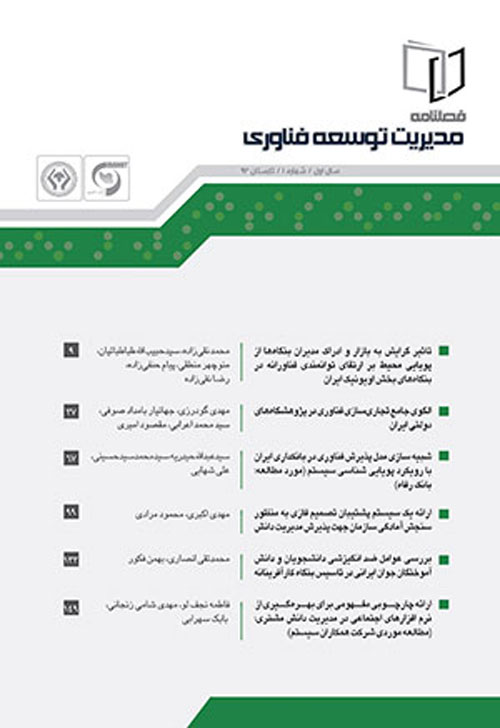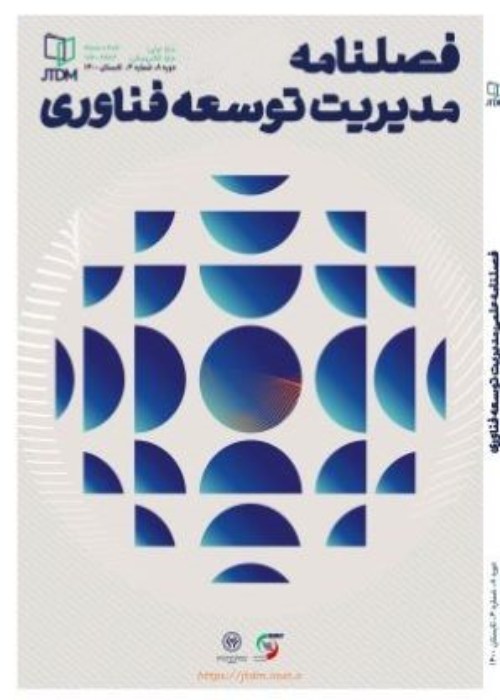فهرست مطالب

فصلنامه مدیریت توسعه فناوری
سال دوم شماره 3 (زمستان 1393)
- تاریخ انتشار: 1394/03/30
- تعداد عناوین: 4
-
- مقاله پژوهشی
-
صفحات 9-33با وجود اهمیت فراوان همکاری های فناورانه به عنوان منبع کلیدی نوآوری و بهبود رقابت پذیری سازمان ها، هر ساله بخش زیادی از همکاری های فناوری در پروژه های مختلف با شکست مواجه می شوند. اصولا ریسک های مختلفی را می توان برای هر همکاری فناوری برشمرد که با شناسایی، ارزیابی و مدیریت این ریسک ها پیش از وقوع می توان احتمال شکست آن را به صورت محسوسی کاهش داد. این تحقیق تلاش دارد تا به این سوال اساسی پاسخ دهد که ریسک های موجود در همکاری های فناوری به ویژه در پروژه های با فناوری برتر حوزه زیست فناوری چه می باشند. جهت پاسخ به این سوال کلیدی تلاش شده است تا تعدادی از پروژه های همکاری فناوری در حوزه زیست فناوری انتخاب و ریسک های مورد نظر شناسایی شوند و سپس شدت تاثیر، احتمال وقوع و احتمال شناسایی هر ریسک نیز با روش های مناسب تخمین زده شود. در این مقاله 46 ریسک مربوط به همکاری های فناوری را در چهار بعد فردی، میان فردی، سازمانی و محیطی طبقه بندی گردید. که ازمیان این موارد ده عنوان ریسک به عنوان ریسک های با عدد اولویت ریسک بالاتر ارزیابی گردید. براساس اولویت بندی صورت گرفته و یافته های تحقیق، پیشنهاداتی جهت کاهش احتمال شکست پروژه های همکاری فناوری ارائه گردید.
کلیدواژگان: همکاری فناوری، عدد اولویت ریسک، احتمال وقوع ریسک، شدت ریسک، احتمال شناسایی -
صفحات 35-54حرکت سیستم تولیدی از سمت تولید صنعتی به فراصنعتی باعث افزایش قابلیت شرکتهای تولیدی در ارائه محصولات با قیمت پائین، کیفیت و انعطاف بالا و تحویل مناسب می شود. بنظر می رسد واحدهای تولیدی با ارائه قابلیتهای رقابتی تولیدی مناسب افزایش سطح عملکرد شرکت را رقم می زنند. در این مطالعه بررسی شده است که آیا می توان قابلیتهای رقابتی تولید را تحت یک سازه واحد تعریف نمود و چگونه ارتباطی بین تکنولوژی های پیشرفته تولیدی با این سازه و عملکرد وجود دارد. برای این بررسی ابتدا از تحلیل عاملی تاییدی و سپس از مدلسازی معادلات ساختاری استفاده شد. نتایج نشاندهنده آن بود که ارتباط معنی دار مثبت بین تکنولوژی تولید، قابلیتهای رقابتی تولید و عملکرد وجود دارد. در ادامه، بحث و نتیجه گیری و در نهایت، محدودیتها و پیشنهادها آورده شد.
کلیدواژگان: تکنولوژی تولید، قابلیتهای رقابتی تولید، عملکرد تجاری، مدلسازی معادلات ساختاری -
صفحات 55-84محصولات و سیستم های پیچیده، نقشی مهم در فعالیت های اقتصادی بنگاه ها، صنایع و کشورها ایفا می کنند و امروزه توجه روزافزونی معطوف به این صنایع گشته است. اما تولید این نوع از محصولات همواره با پیچیدگی همراه است و شرکت ها و سازمان ها قادر نیستند به تنهایی به تولید اینگونه محصولات بپردازند. لذا همکاری فناورانه جزئی جدایی ناپذیر از تولید این نوع محصولات به شمار می آید. این پژوهش پس از ارائه ادبیات مربوط به محصولات و سیستم های پیچیده، به معرفی انواع روش های انتقال فناوری پرداخته و شاخص های مطرح شده در ادبیات جهت انتخاب روش مناسب انتقال فناوری را مورد بررسی قرار می دهد. در ادامه با توجه به نتایج بررسی شاخص ها، انجام مصاحبه و مطالعات تطبیقی انواع مدل های انتقال فناوری مناسب برای مورد مطالعه را شناسایی و پس از توزیع پرسشنامه به رتبه بندی این مدل ها با استفاده از روش ترکیبی AHP و TOPSIS پرداخته است. می توان چنین بیان کرد که انتقال فناوری در این شرکت با استفاده از روش های «ادغام»، «حق لیسانس»، «برون سپاری» و یا «کنسرسیوم» بهترین نتیجه را در پی خواهد داشت.
کلیدواژگان: انتقال فناوری، محصولات و سیستم های پیچیده، همکاری فناورانه -
صفحات 85-108اجرای مدیریت دانش در یک سازمان تغییرات قابل توجهی در سطوح مختلف سازمانی به همراه دارد، که مدیریت این تغییرات نقش به سزایی در موفقیت آن سازمان دارد. این مقاله مدیریت دانش را به عنوان یک تغییر جدید در سازمان بررسی نموده و سپس از میان چالش های مختلف آن، عوامل فرهنگی موثر در تسهیم دانش را شناسایی و بررسی می کند. مطالعه میدانی این پژوهش به وسیله پرسشنامه در سازمان پژوهش های علمی و صنعتی ایران انجام شده است. پنج عامل اعتماد، تعهد، رضایت شغلی، یادگیری و ارتباطات سازمانی به عنوان عوامل فرهنگی موثر در تسهیم دانش شناسایی و بررسی شده اند. نتایج نشان می دهند که در صورت اجرای مدیریت دانش مقاومت های زیادی از سوی افراد صورت خواهد گرفت؛ و به منظور رویارویی با مقاومت افراد در اجرای مدیریت دانش، عوامل فرهنگی فوق بیشترین مانع و در سطح نه چندان مناسبی در سازمان مورد مطالعه ارزیابی شده اند. با وجودی که افراد ظاهرا از اجرای این تغییر استقبال کرده و آن را در رشد و پویایی سازمان موثر می دانند، ولی، در عمل ارزیابی نشان می دهد که آمادگی کافی از جنبه تسهیم دانش، در میان افراد، وجود ندارد و در صورت اجرای مدیریت دانش احتمال رویارویی با شکست، بسیار محتمل به نظر می رسد.
کلیدواژگان: تغییر، عوامل فرهنگی در تسهیم دانش، مدیریت تغییر، مدیریت دانش
-
Pages 9-33Despite technology collaboration is a key source of organizational innovation and competitiveness, many technology collaboration projects are failed each year. We can consider various risks for each technology collaboration but we can increase the probability of project success by identification, assessment and management of these risks. This article tries to response this question what the risks of technology collaboration in hi-tech projects of biotechnology and how much their probability and severity are. To respond this question, some technology collaboration projects in biotechnology sector were selected and the risks were identified. Then their severity, probability and detectability were assessed by appropriate method. In this article, 46 risks of technology collaboration projects in four dimensions-personal, interpersonal, environmental and organizational- were classified. Ten risks were selected as the risks with higher RPN. According to this prioritization and research findings, some suggestions were presented to increase the probability of technology collaboration project success.Keywords: technology collaboration, RPN, Risk Probability, Risk Severity, Detectability
-
Pages 35-54Production system movement from industrial to infrastructural make to increase production firms capabilities in offer products with low price, up quality and flexibility, and suitable delivery. Products with suitable product competitive capabilities peer result to increase performance level of firms. In this paper surveyed could these cometetive capabilities build under one joint construct, and how relation exit between advanced manufacturing thechnology with production cometetive capabilities and performance.in this survey used from conformity factor analysis and then structural equation modeling. Results show positive signtifacant relationship exit between production thechnology, production cometetive capabilities and performance. Then, present discussion and conclusion, and finally, express limitations and purposes.Keywords: Production Technology, Production Competitive Capabilities, Business Performance, Structural Equation Modeling
-
Pages 55-84Complex Products and Systems (CoPS) play an important role in the economic activities of firms, industries and nations and today increasing attention is focused on this industry. However, producing these types of products have always been associated with complexities and uncertainities and firms are not able to produce them without collaboration. Though, technological collaboration is an inseparable part of producing CoPS. This paper first review the literature of complex products and systems, then it studies the different mechanisms of technology transfer and discuss models and factors proposed in the literature for selection of appropriate mechanism of technology transfer. Then, according to the results of studyied indicators, interviews and comparative studies, technology transfer models were identified and ranked by combining AHP and TOPSIS after distributing questionnaires. For this purpose this paper uses questionnair to rank technology transfer mechanisms appropriate to the company using combined approach of AHP and TOPSIS. Findings of this study show that merger, license, outsourcing and consortium are the most appropriate mechanism of technology transfer for this company.Keywords: Complex products, systems, technological cooperation, technology transfer
-
Pages 85-108Knowledge Management in an oranization needs a set of changes in different levels of firms; hence, Change Management has an important role for its success. This paper studies implementing knowledge management, as a new change, in the organization by emphasizing the cultural aspects in knowledge sharing. This research, first identified cultural factors in knowledge sharing, and then, used an experimental way in order to evaluate them in implementation successful knowledge management. For experimental part, a questionnaire is applied in Iranian Research Organization in Science and Technology. Five factors have been identified and studied as the cultural factors affecting knowledge sharing as, trust, commitment, job satisfaction, learning, and organizational communication. The results show that facing the resistance of people, the implementation of knowledge management will occur with a lot of resistance from the people. Therefore, the evaluation of cultural factors in this research doesnt appear in very good level. Although the organizations’s employees appreciate this change, but cultural evaluation shows that there is not adequate preparation in terms of cultural aspects in the organization.Keywords: Change, Cultural aspects, Change Management, Knowledge Management, knowledge sharing


